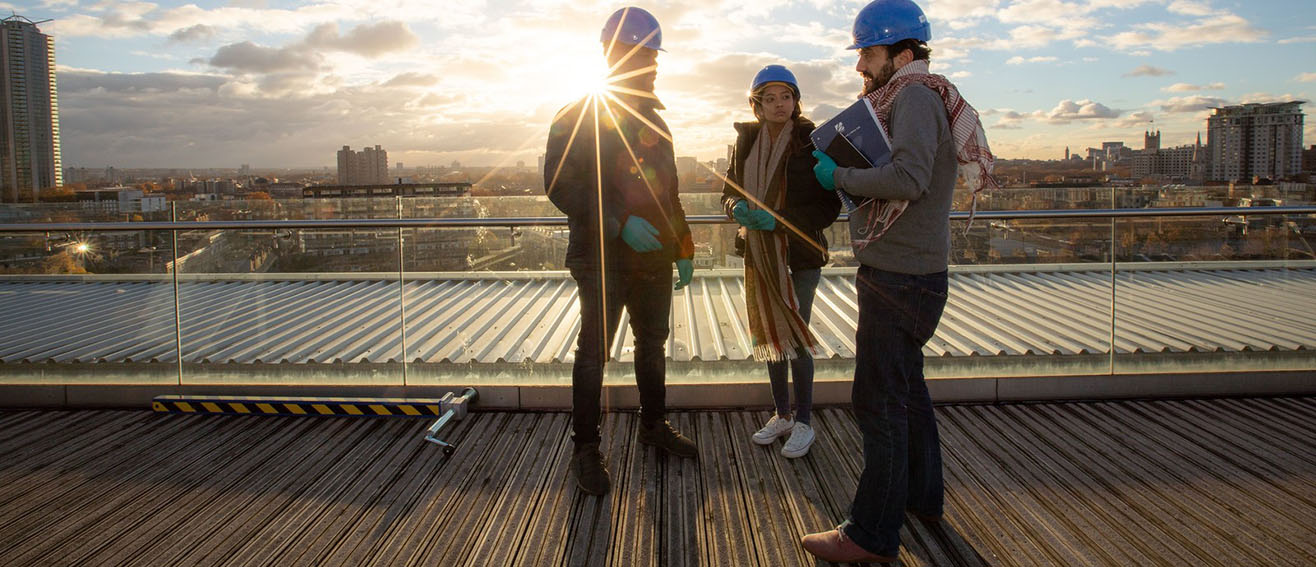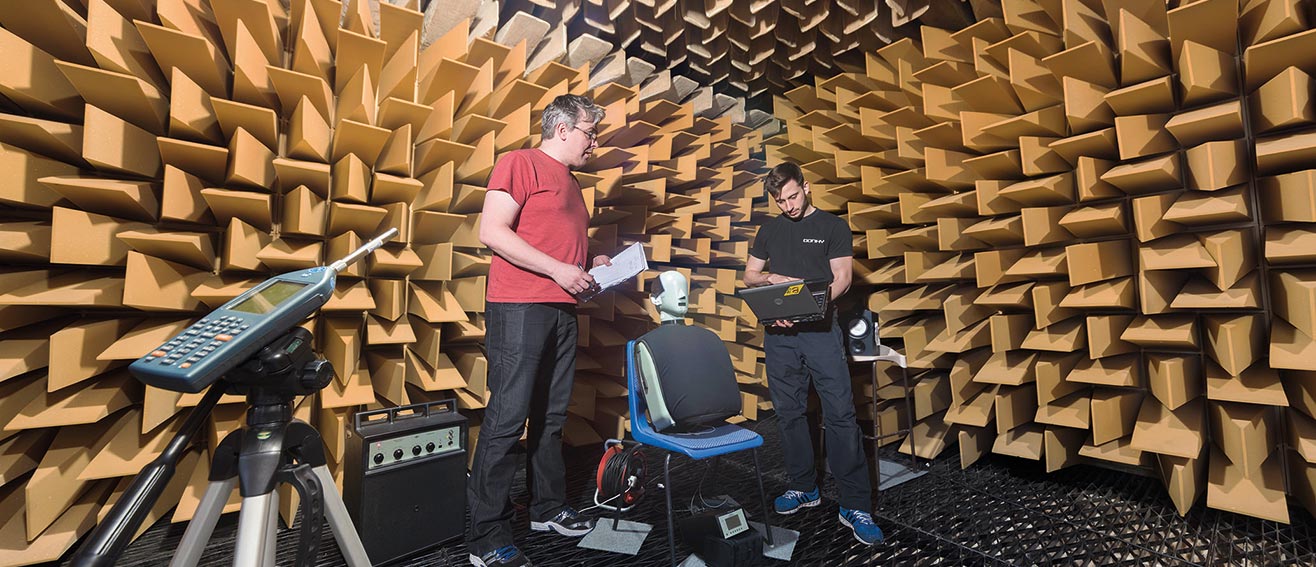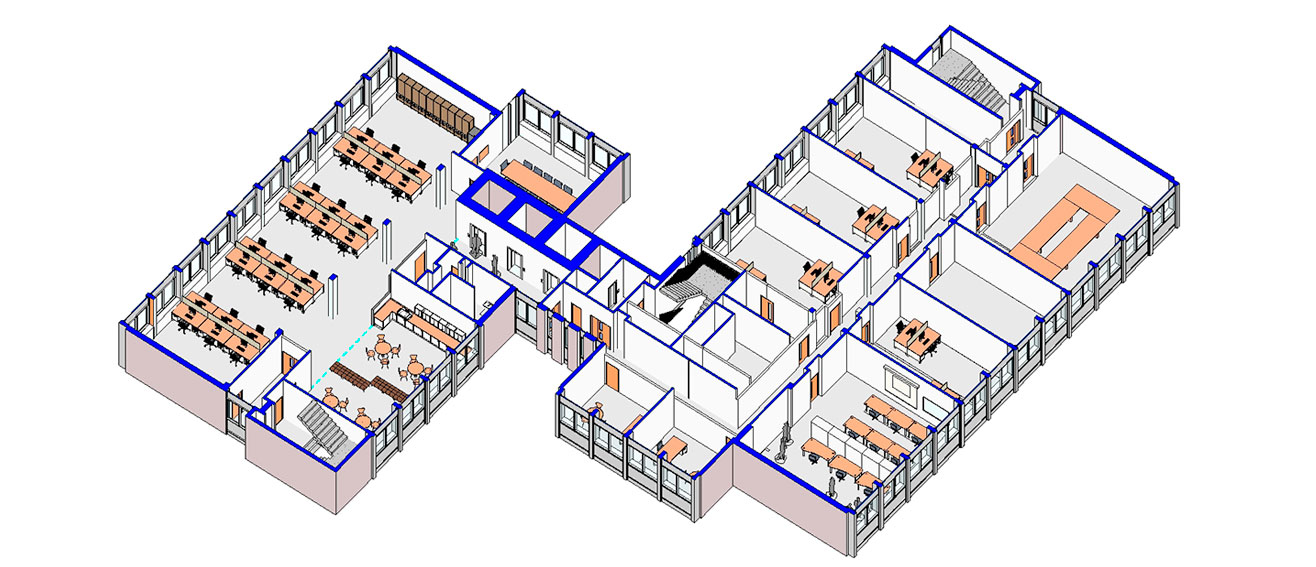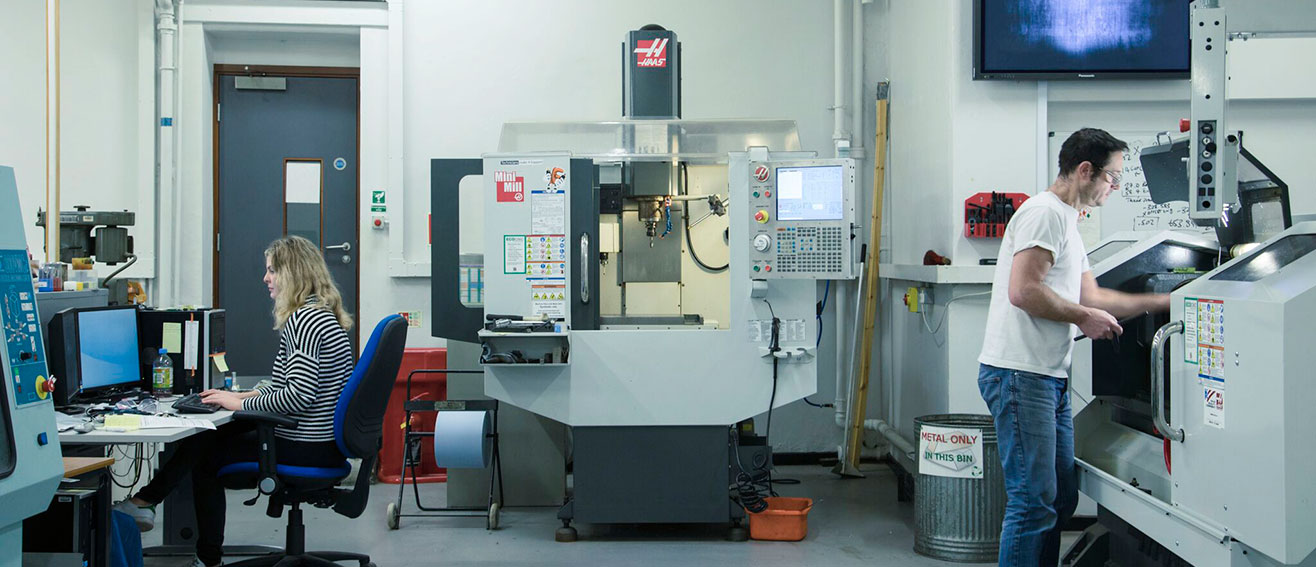
Centre for Civil and Building Services Engineering (CCiBSE)
Engineering the built environment of the 21st century through innovative, interdisciplinary and practical research, based on world leading expertiseLSBU's Centre for Civil and Building Services Engineering Research (CCiBSE) is a truly integrated research centre within the School of Built Environment and Architecture. The centre draws on over 70 years of academic and applied research experience in Energy, Civil and Building Services Engineering , Built Environment, Modelling and LSBU’s solid and long-standing professional reputation in the construction and property industry.
This unique nexus of expertise positions CCiBSE to provide sustainable solutions for the interdisciplinary challenges facing the Built Environment and to deliver positive impact on strategy, policy and practice within the Built Environment.
The centre is committed to developing research that could minimise the environmental impact and carbon emissions associated with the built environment and energy, as well as developing the industry’s skills and providing pathways between fundamental research, applied research, knowledge transfer and enterprise.
CCiBSE has world leading expertise in Civil and Building services engineering. These disciplines have been brought together collaboratively and constructively with the aim of delivering for society on climate change and sustainability.
The research ethos of the centre are to:
- Bring cross sectorial research themes together to innovate distinctive and beneficial collaboration with industrial & other partners
- Develop research and engineering solutions that benefit Society and the Built Environment
- Disseminate and impact policy and practice
Investigated topics
- Integrated Design and Modelling in the Energy and Built Environment
- Building Physics, Comfort & Building Performance
- Advanced Building and Acoustics Materials
- Acoustics, Vibration and Noise Control
- Energy/Heat Recovery, Heat Networks and Thermal Storage
- Energy Management, Power Systems and Quality
- Energy Conversion Technologies - Heat Pumps and/or other novel Low-Carbon Technologies
- Hydrogen Energy Technologies
- Decarbonised Heating, Cooling and Power Generation
- Data Management
- Computational Fluid Dynamics and Geomechanics
- Coastal and Ocean Engineering
- Structural Fire Safety and Fire Design
- Structural Design and Reliability
- Highways and Transportation Infrastructure Engineering
- Structural Mechanics and Analysis
- Waste Management and Circular Economy
- Water and Environmental Engineering
- Policy Implementation
Current projects
We have had significant success in securing funding for a number of energy and applied research projects, and host a number of match-funded research projects and Green Tech A2I projects funded by the European Union.
Balanced Energy Network (BEN)
The Balanced Energy Network (BEN) is a £4 million project part-funded by Innovate UK. The BEN consortium brings together cross-sector supply chains to deliver integrated energy solutions at different scales to meet the energy systems challenges of achieving a low-carbon economy: secure, affordable, sustainable energy.
This project is the first investigative pilot study in the world that is delivering both physical and digital network knowledge to integrate systems that will enable the balancing of heating, cooling, electricity and carbon to minimise costs – and help combat global warming.
Home Energy 4 Tomorrow (HE4T)
The Home Energy 4 Tomorrow (HE4T) project is an academic and industry collaborative research project funded by innovate UK to develop a dual source heat pump (DSHP), capable of linking with both air and water heat sinks.
Project partner ICAX Ltd. has created a prototype proving the flexibility and efficiency benefits of a DSHP. This research project will take this starting point and develop a heat pump for mass application in both new build and retrofit markets. This solution will offer a more efficient pathway to the electrification of domestic heat. The development work will take place at the laboratories of London South Bank University.
An exciting strand of this project is the development of the potential for water utilities to play a role in accelerating the uptake of electrified heat. HE4T will be looking at how water systems can be connected to the DSHPs to boost efficiency – turning the water utilities into energy carriers. This work is supported by Thames Water and Anglian Water, as part of their ongoing energy innovation work.
Decarbonised Heating and Cooling with Advanced Technologies
A novel research project has been launched to develop a new way of recovering waste heat from industry and decarbonise heating and cooling through new technologies. This research project is led by London South Bank University (LSBU) and CCiBSE and funded by the Engineering and Physical Sciences Research Council (EPSRC).
The research team in this EPSRC project will investigate new ways of providing heating and cooling from energy intensive industries including steel, glass, paper, food and cement etc.
The new technologies which will be studied include waste heat recovery at various grades, long-distance transport networks to transfer recovered energy more efficiently and advanced heating and cooling systems.
Other projects
- Royal Academy of Engineering (RAE) Institutional link with Institute of Technology Bandung, Indonesia on Developing Indonesian Coastal Areas as Sustainable Tourism.
- Short Course IOA certificate on competence
- Biomedical acoustics, Communication and Rooms (Special Interest Group of the UK Acoustic Network), UKAN, funded by EPSRC since March 2018.
- Royal Opera House match-funded Scholarship.
- Royal Academy of Music to design solutions to improve the environment for musicians Match-funded PhD.
- Patent for Fire Cladding
- Endothermic Heat project
- Henry Wood Hall
- Decarbonised Transport
Key facilities
Acoustic facilities

Our centre house the best academic acoustic facilities in the South-East of England, including a full-size reverberant and anechoic chambers, as well as an exceptionally well equipped laboratory, featuring the very latest instrumentation and technology. Our anechoic chamber was featured by UNILAD.
Both chambers can be used for simulating idealised acoustic conditions for researching a number of noise phenomena: sound power determination, binaural recordings, measuring source directivity, the testing of hearing protectors and the demonstration of fundamental acoustic principles.
Centre for Efficient and Renewable Energy in Buildings (CEREB)
CEREB is unique resource supporting policy engagement, teaching, research and demonstration of low carbon energy technologies in the built environment.
Environmental chamber
The environmental chamber is a flexible Climate Simulator used for controlled testing and developing new techniques and systems. It allows us to construct full-scale and scaled environments to better understand climatic influence and be capable of controlling strict environmental conditions.

Building Information Modelling (BIM) Centre
BIM is an approach to managing and planning every aspect of design and operation in the construction process in a better, more efficient way to improve the basis upon which the construction industry and its clients operate. The BIM Centre acts as a hub for innovation, professional training and networking amongst practice experts in the built environmental sector.
Strengths of Materials laboratory

The Strengths of Materials laboratory at London South Bank University offers state-of-the-art testing facilities, capable of performing product qualification testing and aiding knowledge development for structural assemblies and structural and mechanical components.
The apparatus available allow for testing of a wide range of components, including slabs, beams, floor joists, roof trusses, wall panels, floor system components, connection details, compression members and struts, both at room temperature and at temperatures up to 1200°C.
Our mechanical loading rigs can test up to 100 kN, 250 kN and 500 kN, respectively, and are adaptable to accommodate a wide range of structural systems in tension, compression, bending and shear. We have previously conducted product qualification and knowledge development testing for modular construction contractors, chipboard manufacturers and CLT manufacturers.
Other facilities
- Lighting Laboratory
- Building Services Laboratory
- DARLAB (Digital Architecture and Robotic Lab)
The Centre also has access to other general engineering facilities within the University, including the Engineering and Welding Workshops, the Machine Shop, the Modelling Workshop, plus many other design and soft facilities.
Contact us
To enquire about our research and facilities, please contact:
- Professor Yunting Ge (Centre Director) E: yunting.ge@lsbu.ac.uk T: 020 7815 7177
- Aleya Islam E: islama18@lsbu.ac.uk T: 020 7815 7652
Our centre members have an established track record of impactful applied research, working with a wide variety of industrial and academic partners to achieve significant environmental, social and economic benefits to the field. We also have a number of early carrier researchers who have the passion and enthusiasm to link with industry and deliver impactful research.
Associate members
- Shazia Ali
- Mahmood Datoo
- Carlos Gonzalo
- Mike Gunn
- Ivana Kraincanic
- Simon Leung
- Luis Pinho Santos
- Bridget Shield
Current PhD students
- Faisal Abdulle
- Fadhel Alasadi
- Eric Ballestero
- Syed Faisal Ali
- Mugdad Alkhateeb
- Imad Ezzat Dagher
- Shirin Ghanei
- Fouad Ghoussayni
- Robert Kovacs
- Muhammad Safdar
- Rodrigo Sanchez-Pizani
- Haddowe Shatha
- Douglas Shearer
- Majed Al Shimari
- Xinyu Zhang
- Pingyuan Lang
Recently completed PhDs
- Alexander Cowan David
- Nicholas David Durup
- Ben Dymock
- Samson Ezekiel
- Christina Johanna Francis
- Amber Khuram
- Peter Mapp
- Alex Mayes
- Pegah Mirzania
- Ehsan Mohammadzadeh Miri
- Lorenzo Morales
- Joseph Ndjana Levodo
- Gizem Okten
- Oluremi Olufunmilayo Kayode
- Uzonna Onyia
- Akos Revesz
- Khan Riaz
- Samuel Tade Oluwagbenga
- Elizabeth Whelan
- Metkel Yebiyo
We have a number of strong research collaborations and partnerships as well as established links with governmental and professional bodies.
CCiBSE partners
The centre through its members has strong links with the various subjects area professional bodies including:
- The Chartered Institute of Building Services Engineering
- Energy Institute
- The Institute of Refrigeration
- The Institute of Acoustics
- The Institution of Civil Engineers
- The Institution of Structural Engineers
The centre also has reach portfolio of working with industrial partners in research and consultancy. These include:
- ICAX
- Minus7 Ltd
- TopHat Labs Limited
- Wandsworth Borough Council Heliport Noise Monitoring
- Royal Opera House match-funded Scholarship
- Foster & Partners- Listening to London
- Henry Wood Hall - Knowledge Exchange Voucher
- Royal Academy of Music Match-funded PhD
- BSRIA
- Ricardo PLC
Past collaborations have also included multidisciplinary research networks and knowledge transfer partnerships. In line with LSBU’s fundamental believes, the centre welcome new academic/industrial collaborations.
Academic collaborators
- Institute of Technology Bandung, Indonesia
- Applied Science University- Bahrain
- British University in Egypt
- University of Dar-es-Salaam
- Dr Ham of the Korea National Rural Research Institute. Dr Timothy Hong is working with Dr Ham on an international collaboration project on water quality modelling and management affected by the rainfall-runoff process in the rural catchment
- University College London
- Imperial College
- Universitat Politècnica de Catalunya (UPC)
- Instituto Superior Técnico (IST) - University of Lisbon
- Lancaster University
- University of Sheffield
- Mechanical, Aerospace and Civil Engineering Department, Brunel University London, UK
- Department of Structures for Engineering and Architecture, University of Naples Federico II, Italy
- ERAMUS Scholarship related to air quality modelling in May, 2018.
Other partnerships
We are involved in a range of outreach activities with the aim of promoting, enhancing and enriching research and students’ experience. These include:
- The Teambuild construction challenge which has been supported by CCiBSE members since 2014. This is a training competition for young people in the construction industry, and a chance for young engineers, architects, construction/design managers, consultants, and contractors to prove and improve their skills.
- UK Passivhaus Events
- The Balanced Energy Network (BEN) innovative industry and academia collaborative research project shortlisted for the Engineer: Collaborate to Innovate Awards, 2018.
- Collaboration with the Royal Opera House and the Royal Academy of Music, complimented through a matched funded PhD to design solutions to improve the environment for musicians
- Established strong academic collaborations with the British University, Egypt and Applied Science University, Bahrain. We also hold strong research links with the Institute of Technology in Bandung, Indonesia through two RAE projects looking at plastics waste and developing Indonesian Coastal Areas for Sustainable Tourism.
Collaborative team building events
- Teambuild construction challenge supported since 2014. Young engineers, architects, construction/design managers, consultants, and contractors collaborate to improve their skills
- The CIBSE Technical Symposium 2018
- 35th anniversary CIBSE Patrons 2018
- EPSRC UK Acoustics Network
Key publications
- Gillich, A., Icon, O., Sunikka-Blank M., and Ford, A., (2017), Designing an ‘optimal’ domestic retrofit programme, Journal of Building Research & Information, Volume 46, 2018 - Issue 7, Pages 767-778.
- Averill, A., Ingram, J., Gomez-Augustina, L., Holborn, P., Battersby, P., and Benson, C. (2018). Potential hazard consequences to personnel exposed to the ignition of small volumes of weakly confined stoichiometric hydrogen/air mixture. International Journal of Hydrogen Energy.
- Chaer, I., Pope, I., Yebyio, M., Paurine, A., (2018), Smart cities – Thermal networks for London, Journal of Thermal Science and Engineering Progress 1-9 (9 pages) 26 Jul 2018.
- Dance, S., Morales, L., Backus, B., (2018), A methodology to objectively assess the performance of sound field amplification systems demonstrated using fifty physical simulations of classroom conditions, Noise and Health, 20 (94), 77-82,.
- Ye, Z., Lawner, H., Chaer, I., Ross, M., (2018), Feasibility Study of Pumping Cycle Kite Power System Implication in Scotland UK. 2018 3rd International Conference on Renewable Energy and Conservation, 15 – 17 June 2018, Sydney, Australia
- Aygün, H. and Barlow, C., (2015) “Ultrasonic wave propagation in porous rigid ceramics at oblique incidence”, Applied Acoustics. Vol.88, 6-11. https://doi.org/10.1016/j.apacoust.2014.07.011
- Limbachiya, V. , Ganjian, E. and Claisse, P. (2016), Strength, durability and leaching properties of concrete paving blocks incorporating GGBS and SF, construction and Building Materials, volume 113: 273-279
- Mavroulidou, M. (2018). Use of paper sludge ash as a calcium-based stabiliser for clay soils. Waste Management and Research doi: https://doi.org/10.1177/0734242X18804043,
https://doi.org/10.1177/0734242X18801196. - McCann, F., Fang, C., Gardner, L. and Silvestre, N., (2016) Local buckling and ultimate strength of slender elliptical hollow sections in compression. Journal of Engineering Structures, 111, 104–118.
- Levatti H. U., Prat, P.C., and Ledesma. A., (2018) Numerical and experimental study of initiation and propagation of desiccation cracks in clayey soils. Computers & Geotechnics (doi.org/10.1016/j.compgeo.2018.09.015). https://authors.elsevier.com/a/1XtsP,63b~kRN4
- McGovern DJ, Robinson T, Chandler ID, Allsop W, Rossetto T, (2018), Pneumatic long-wave generation of tsunami-length waveforms and their runup, Coastal Engineering 138, 80-9
- Saber, EM and Iyengar, R and Mast, M and Meggers, F and Tham, KW and Leibundgut, H (2014) Thermal comfort and IAQ analysis of a decentralized DOAS system coupled with radiant cooling for the tropics. Building and Environment, 82. pp. 361-370. DOI https://doi.org/10.1016/j.buildenv.2014.09.001.
- Shamass, R., and Cashell, K.A. (2018). Analysis of Stainless Steel-Concrete Composite Beams. Journal of Constructional Steel Research doi: https://doi.org/10.1016/j.jcsr.2018.05.032
- Levatti, H.U. ;Pere C. Prat & Alberto Ledesma. (2019) Numerical and experimental study of initiation and propagation of desiccation cracks in clayey soils. Computers & Geotechnics. Vol 105 (155-167). (https://doi.org/10.1016/j.compgeo.2018.09.015)
- Levatti, H.U.; Prat, P.C.; Ledesma, A.; Cuadrado, A. & Cordero, J. (2017). Experimental analysis of 3D cracking in drying soils using Ground Penetrating Radar. Geotechnical Testing Journal Vol 40 Issue 2 23 pages (DOI: 10.1520/GTJ20160066)
- F. McCann, L. Gardner. 2019. Numerical analysis and design of slender elliptical hollow sections in bending. Thin-Walled Structures, 139:196–208.
- W. Qiu, F. McCann, A. Espinos, M. Romero, L. Gardner. 2017. Numerical analysis and design of concrete-filled elliptical section columns and beam-columns, Engineering Structures, 131:90–100.
- Y.T. Ge, L. Li, X. Luo, S.A. Tassou. Performance Evaluation of a Low-grade Power Generation System with CO2 Transcritical Power Cycles. Applied Energy,227(2018) 220-230.
- W. Youssef, Y.T. Ge, S.A. Tassou. Effects of latent heat storage and controls on stability and performance of a solar assisted heat pump system for domestic hot water production. Solar Energy 150 (2017) 394–407.
- McGovern, D. J., Todd, D., Rossetto, T., Whitehouse, R. J. S., Monaghan, J. and Gomes, E., (2019). “Experimental observations of tsunami induced scour at onshore structures.” Coast. Eng.Volume 152, 10.1016/j.coastaleng.2019.103505.
- McGovern, D. J., Chandler, I. D., Allsop, N. W. H., Robinson, T. and Rossetto, T. (2018). “Pneumatic long-wave generation of tsunami-length waveforms and their runup.” Coast. Eng. 138 80–97. DOI: 10.1016/j.coastaleng.2018.04.006
- L. Barbierato, A. Estebsari, L. Bottaccioli, E. Macii and E. Patti, “A Distributed Multi-Models Co-Simulation Platform to Assess General Purpose Services in Smart Grids,” IEEE Transactions on Industry Applications, 2020.
- A. Estebsari and R. Rajabi, “Single Residential Load Forecasting Using Deep Learning and Image Encoding Techniques,” MDPI Electronics, 2020.
- L. Bottaccioli, A. Estebsari, E. Patti, E. Pons, A. Acquaviva, "Planning and real-time management of smart grids with high PV penetration in Italy," Proceedings of the Institution of Civil Engineers - Engineering Sustainability, 2019.
- I. Khajenasiri, A. Estebsari, M. Verhelst, G. Gielen, “A Review on Internet of Things Solutions for Intelligent Energy Control in Buildings for Smart City Applications,” Energy Procedia, Volume 111, March 2017, Pages 770-779, ISSN 1876-6102, 2017.
- Safdar M. U., Mavroulidou, M., Gunn M. J., Garelick J, Payne I., Purchase D., (2021) “Innovative methods of ground improvement for railway embankment Peat Fens foundation soil”, Géotechnique, https://doi.org/10.1680/jgeot.19.SiP.030
- Mengasini, L. Mavroulidou, M. Gunn M.J. (2021)Alkali-activated concrete mixes with ground granulated blast furnace slag and paper sludge ash in seawater environments, Sustainable Chemistry and Pharmacy 20(2):100380 DOI: 10.1016/j.scp.2021.100380
- Haydar Aygün and Finian McCann, 2020. “Structural and acoustical performance of recycled glass bead panels”. Journal of Construction and Building Materials. Volume 258, 119581. (Impact factor, 4.419) https://doi.org/10.1016/j.conbuildmat.2020.119581
- Haydar Aygün, and A. Apolskis, 2020. The quality and reliability of the mechanical stethoscopes and Laser Doppler Vibrometer”. Journal of Applied Acoustics. Volume 161, 107159. (Impact factor, 2.44) https://doi.org/10.1016/j.apacoust.2019.107159
- Haydar Aygün, 2019. ‘A viscoelastic system for determining acoustical and mechanical parameters of the bone’. Journal of Applied Acoustics. Volume 150, Pages 70-75. (Impact factor, 2.44) https://doi.org/10.1016/j.apacoust.2019.01.034.
- Ballestero E., Aygün H., Jiménez N., Groby J. P., Dance S., and Romero-García V., 2019, “Experimental validation of deep-subwavelength diffusion by acoustics meta-diffusers”. Journal of Applied Physics Letters. Vol 115. (Impact factor, 3.597) https://doi.org/10.1063/1.5114877.
The Coastal Hazards Group in CCiBSE specialises in understanding the interaction of extreme seas with the built environment. The research develops an understanding of the forces, sediment scours, and other failure modes at coastal structures, helping engineers to mitigate the effects of extreme coastal inundations. This is achieved through a combination of physical and numerical modelling techniques.
The Group lead is Dr David McGovern Academic Staff
David has expertise in physical modelling of sediment scour, and fluid structure interactions.
Members :
Dr Keith Adams - Academic Staff
Keith researches cascading hazard risk, with focus on storm surge, extreme events, earthquake, landslides and tsunami. Linear infrastructure and heritage structures are of particular interest.
Mr Carlos Gonzalo - Academic staff
Carlos has expertise in fluid mechanics and innovation development.
Dr Sabana Parvin – KTP PDRA
Sabana is the KTP PDRA working on the TSuTwin Project. She has a PhD in Mathematics and expertise in CFD.
Mrs Niki Soleimani - PhD scholar - Research students
Niki is a PGR scholar Jan 2024 – 2027 researching tsunami scour at onshore structures through experimental and numerical methods.
Collaborators:
Professor Rodney Day - Academic staff
Rodney is PVC of Research and Enterprise at LSBU, and has a track record of hydraulic engineering and scour.
Recent Publications from the Laboratory:
- Observations from the EEFIT-TDMRC mission to Banda Aceh, Indonesia to investigate the recovery from the 2004 Indian Ocean Tsunami. Baiguera, M., Raby, A., McGovern, D., Adams, K., Meilianda, E., Idris, Y. and Veriyanti, V.
- Large-Scale Experiments On Tsunami Inundation And Overtopping Forces At Vertical Sea Walls McGovern, D., Allsop, W., Rossetto, T and Chandler, I. https://doi.org/10.1016/j.coastaleng.2022.104222
- Experimental observations of tsunami induced scour at onshore structures. McGovern, D, Todd, D, Rossetto, T, Whitehouse, RJS, Monaghan, J and Gomes, E https://doi.org/10.1016/j.coastaleng.2019.103505
Funding wins:
2023 AKT269: Tsunami Experimental Study £36k, PI Dr McGovern
2024 - 2026: KTP LSBU HR Wallingford - TsuTWin. £200k PI Dr McGovern, Co-I Mr Carlos Gonzalo
TsuTWin - Tsunami Twin Wave Generation Laboratory
TsuTWin is a £200k Knowledge Transfer Partnership (KTP) with HR Wallingford to develop the world's first physical laboratory for tsunami wave train and return flow generation.
Currently, there is no method to generate the deadly return flow of tsunami - a major cause of destruction. Neither is there any method to generate repeat waves, otherwise known as tsunami wave trains. TsuTWin will change that by developing a laboratory generation system that will be able to generate incoming, returning and multiple tsunami waves. This will lead to better facilities for scientists and engineers to understand how these waves are so destructive and mitigate against them. Ultimately protecting life and property.
The project is funded by Innovate UK, PI Dr David McGovern, and administered by Nil Atmaca. For further information, please contact David McGovern or Nil Atmaca.
Tsunami Scour
Tsunami scour is a major cause of structural failure in events such as the 2004 Indian Ocean Tsunami and the 2011 Great Eastern Japan Tsunami. Scour is the removal of sediment around the foundations of structures under tsunami attack. Currently one PhD international scholar is using experimental data to develop a numerical model to understand the process fully.
For further information contact Mrs Niki Soleimani
Tsunami interactions with coastal structures
Our external Collaborators:
University College London
HR Wallingford Ltd.
University of East London